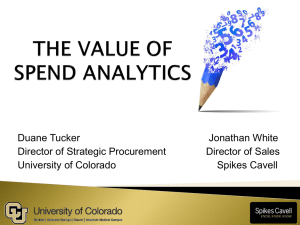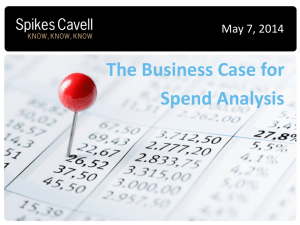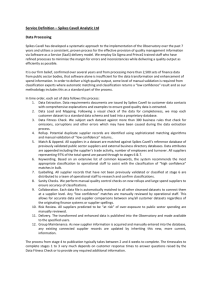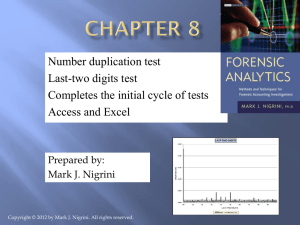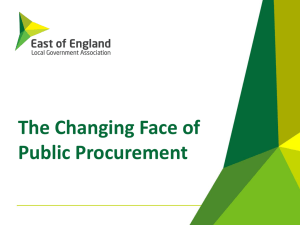the Business Case for Spend Analysis Word document
advertisement
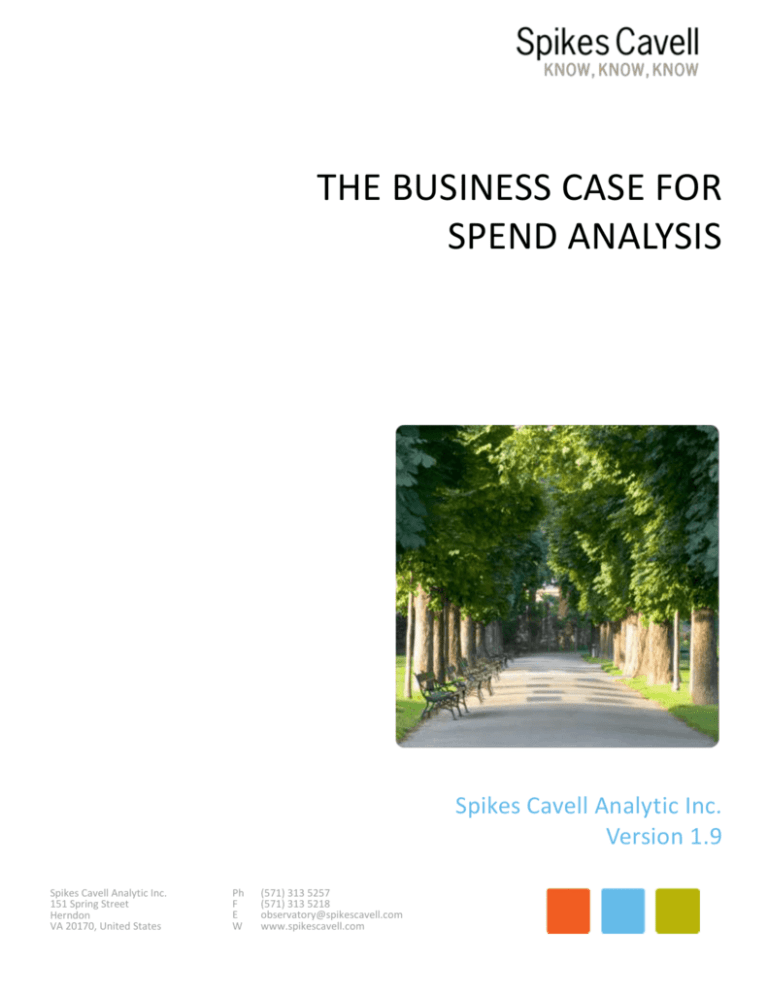
THE BUSINESS CASE FOR SPEND ANALYSIS Spikes Cavell Analytic Inc. Version 1.9 Spikes Cavell Analytic Inc. 151 Spring Street Herndon VA 20170, United States Ph F E W (571) 313 5257 (571) 313 5218 observatory@spikescavell.com www.spikescavell.com HOW TO USE THIS BUSINESS CASE Organizations who want to begin a spend analysis project sometimes have difficulty in articulating why they need outside assistance to budget holders and decision makers within their organization. In other cases they simply don’t have time to write their own business case. This document is designed to provide procurement professionals with information to support them in demonstrating to their organization’s leaders that it is worth the time and money to undertake a spend analysis project. The text in this business case is for you to use in any way that you need to in order to create your own business case for spend analysis. You are welcome to copy and paste all or any part of the text below “as is” directly into your own emails, presentations and memos or to modify and rearrange it to create your own business case documents. If you need clarification or more information about any of the points below, please contact a member of Spikes Cavell’s staff and we will be happy to assist you. This document includes sections on: What is spend analysis? What could you achieve with better data and visibility through spend analysis? Why not do spend analysis by yourself? Where does the data come from for spend analysis? What are the main difficulties of the “Do It Yourself” approach? What about auto classification? Why you should work with Spikes Cavell WHAT IS SPEND ANALYSIS? The underlying rationale for a spend analysis project is to gain a clearer understanding of an organization’s expenditure and how it might be managed better. Using detailed spend information as a basis for discussion makes it much easier to have informed conversations with buyers and stakeholders, to influence and change behavior, and to deliver savings and efficiencies. Spend Analysis has two principle steps. The first step is the collection of an organization’s raw, historic expenditure data from all available sources and the transformation of that raw data into information that the procurement team can use. The second step is to provision of a set of tools that deliver a platform for procurement professionals to analyze and manage their organization’s spending. Good analysis tools are important, but if the data they are analyzing is poor, the outputs will be inaccurate which will result in wasted time and effort. Page | 2 WHAT COULD YOU ACHIEVE WITH BETTER DATA AND VISIBILITY THROUGH SPEND ANALYSIS? Spend analysis can help you deliver savings and efficiencies for the organization by: - ensuring that all departments are getting the same 'best rates' and terms with each vendor; using the data in competitive processes and supplier negotiations to strengthen the organization's information advantage and negotiating position with suppliers; identifying opportunities to implement or renegotiate contracts based on actual spend value rather than estimated values or values provided by the supplier; creating and utilizing category analysis reports to aggregate demand and drive down costs in categories of spend that span the entire organization; identifying opportunities for greater internal and external collaboration in procurements; and making it easy to access spend information so that time and resources can be focused on delivering savings rather than cleaning up data and struggling with complicated analysis tools. Spend analysis can help you bring more of your spend under management by: - providing a solid foundation of information for decision making which includes an aggregated view of spend from all systems and transaction types; identifying the key areas of spend that should be targeted by professional procurement teams; identifying non-compliant spend, enabling procurement teams to work with buyers and suppliers to maintain a high level of spend under contract; profiling and managing suppliers according to levels of value, risk, and potential opportunity for savings; and enabling the benchmarking and measurement of procurement performance over time. Spend analysis can help you change buying behavior within the organization by: - - providing key stakeholders with visibility of spend on goods and services, going way beyond simply whether or not spend was under or over the allocated budget; making it easy to create and use departmental spend reports to help department managers and people with budget responsibility more effectively manage their spend, save money, and use those savings to deliver on their missions; monitoring compliance against contracts, financial standing orders and procurement thresholds; identifying non-compliant spend and deliver the management information necessary to take action and have informed conversations with buyers and managers; identifying suppliers with large numbers of transactions where there may be opportunities for accounts payable efficiencies through consolidated invoicing, eProcurement or purchasing cards; monitoring the number of transactions without purchase orders so that the procurement team can take steps to ensure that spend goes through the proper approval processes; and identifying opportunities for greater internal collaboration. The identification of common suppliers and categories of expenditure across multiple departments provides valuable information for negotiating with Page | 3 suppliers to drive down prices and reducing the administration of multiple contracts, vendors and competitive processes. Spend analysis can help you monitor and maximize the impact of dollars spent: - with small and medium sized business; with local companies; with minority owned business enterprises; and assess the potential impact of procurement decisions on these groups. WHERE DOES THE DATA COME FROM FOR SPEND ANALYIS? Most organizations have a huge volume of data about their spend, held in a variety of systems designed to support a specific transaction stage or process. These systems typically produce the following types of data: Accounts payable data: This type of data provides the broadest view of what has been spent with each supplier, but the only data available to determine what the money has actually been spent on is the organization’s own financial codes. Classification is frequently performed by the buyers making the purchase who are not subject matter experts, nor is there often enough of a carrot or stick to encourage them to take their time and code transactions correctly. This often results in classification errors, particularly where purchasing authority is decentralized, and which makes accurate analysis of spend difficult. eProcurement data: eProcurement systems can be very useful, but seldom provide a comprehensive view of all spend; only the 10-20% of total expenditure that actually goes through that system. Data captured in an eProcurement system is usually more detailed than accounts payable data, especially if transactions are driven through catalogs. Where catalog items are classified to a standard taxonomy such as NIGP Code, this provides a more consistent base for analysis. One issue to be aware of is that, in many cases, these implementations rely on the supplier to append the correct classification code. Most suppliers are not classification specialists which can lead to errors in classification of catalog items. Purchase card data: Purchasing card transactions are typically classified to a merchant category code, which often does not match the coding in the accounts payable or eProcurement systems, if the transactions are classified at all. In categories like travel, it is common for an organization to complete smaller value transactions using a PCard and with the same supplier also receive invoices to accounts payable for larger transactions. With transaction data coming in from different sources, in different formats, and sometimes with different names for the same vendor, it can be difficult to get full visibility of spend with a single supplier across two transaction methods. Contract data: Information about the contracts an organization has in place usually resides in a separate contract management system, if contract data is systematically recorded and kept up to date in an electronic format at all. Matching lists of contracted suppliers to expenditure data is often carried out manually and only for those suppliers and contracts with higher spend values. The matching of suppliers and spend to contracts is instrumental in identifying maverick expenditure. Due to the complexity and volume of expenditure data from all of these sources, reviewing spend with a single vendor, spend in a particular category, or understanding how much was spent through a single contract can take hours or days Page | 4 of administrative effort. The sheer volume of data being analyzed can take hours to process using industry standard, off the shelf applications. Certain attributes of the data itself will make analysis difficult. For example, there are likely to be many different names for the same vendor that exist in different systems (AT&T, ATT, AT & T Wireless, A.T.T., ATTM) as well as inconsistently applied item or vendor classifications (Office Supplies, Stationery, Other Office Equipment and Retail Stores all used to describe the same vendor or commodity) which make it difficult to analyze the data without spending a significant amount of time cleaning it up first. With cleansed, classified and aggregated data and quality business intelligence tools, analysis should take minutes. WHY NOT DO SPEND ANALYSIS BY YOURSELF? Public sector and higher education organizations frequently struggle with step one of the spend analysis process; transforming raw expenditure data into information that is fit for purpose. Many procurement teams do not have the necessary staff, resources, skills or suitable technology to undertake the data aggregation, cleansing and classification work that’s needed just to get the data in the right shape to analyze. Even if the data is in good shape and it is possible to extract it in a usable format, most procurement teams do not have skilled data analysts, easy to use analytical tools, or the facility to easily distribute the information to the business managers and operational staff that need it. WHAT ARE THE MAIN DIFFICULTIES OF THE “DO IT YOURSELF” APPROACH? It is not unreasonable to assume that it should be possible to analyze spend data using internal resources. However, there are some things to consider before going down that road: When transaction data is extracted from the accounts payable, eProcurement and PCard systems, it is often provided to users in a very raw state and in multiple files. The procurement team who need to use the data are not usually data analysts, so getting what they need from the data in its raw state is just too difficult or too timeconsuming. Assuming that the resources are available to extract data from these multiple systems so that it is available for analysis projects, in its raw state, the data requires significant time, staff resources and database skills to aggregate, cleanse and classify the data before it is in a usable state. De-duplication of vendors across multiple files and classification of vendors and spend are both time consuming and difficult to complete consistently and accurately, but are essential if the data is to be fit for purpose. Internally developed business intelligence solutions are often difficult to distribute access to and support end users beyond a very limited audience. These difficulties mean that either the information is severely underutilized, or an extra internal team of analysts is needed to respond to specific requests for information. Quite often, the key stakeholders and senior executives who really need the management information never get to see it. Working in collaborative groups or comparing expenditure to other organizations brings additional challenges because data needs to be gathered and aggregated across those organizations. Aggregation, cleansing and Page | 5 classification of multiple datasets together just multiplies the difficulties an individual organization faces in getting better spend visibility. WHAT ABOUT AUTO CLASSIFICATION? There are providers of business intelligence tools that claim to have artificial intelligence based auto-classification processes built in. Software-based solutions often result in hidden costs which make the solution appear less expensive at the initial outlay. This is because the time and resources required to set up, teach and maintain the auto-classification tool end up with the customer. Here are some points to consider about auto cleansing and classification processes if you’re thinking about using them: Auto cleansing and classification is based on a set of business rules that recognize a text string. Most tools will come with a set of pre-built business rules based on a reference database of historical datasets that have been previously processed. Where classification or cleansing is not achieved, it is usually the responsibility of the customer to define and write the additional business rules that will allow the system to improve the accuracy of the information. This only works if the skilled resources exist in your organization and are available when you need them. Auto classification of line level data depends entirely upon the free-text descriptions and internal line level classifications held in the buying organization’s source data. If the descriptions or coding are ambiguous or incorrect, it is usually the responsibility of the customer to correct the errors. Again this can be a viable approach if the skilled resources are available internally, or if the underlying data is high quality and complete. Automated matching to external databases to enhance supplier records alone usually only achieves up to 60% match rate accuracy. If no manual validation is offered, it is the responsibility of the customer to classify the remaining suppliers. WHY YOU SHOULD WORK WITH SPIKES CAVELL Since 2003, Spikes Cavell has processed more public sector and higher education datasets in the UK and US than any other service provider. We have accumulated an unrivalled body of real-world experience working with individual organizations as well groups of over 160 separate buying entities. Spikes Cavell specializes in this area because there is a real need for high quality and consistent data cleansing and transformation, pre-configured reporting tools that don’t take months to customize and learn, and the computing power to process and display large volumes of data quickly. Spikes Cavell can solve both your data and reporting challenges faster, cheaper and better than using in-house resources. Spikes Cavell has developed sophisticated de-duplication, matching and auto-classification processes which don’t require the customer’s time and resources to deliver high quality results. Where a computer rule can identify a match or recognize a specific text string, the match makes the process of classification repeatable, quicker to do and more cost effective. However we know that without human involvement, the data will never be fit for purpose and that our customers don’t usually have the time or staff to manually validate classifications and teach the system. Because our primary focus is on delivering high quality data, low confidence matches are manually validated by Spikes Cavell Page | 6 classification experts at each stage of the data cleansing and enhancement process and these analysts make pragmatic decisions that no computer rule could replicate. Transformation of the data is done for you by an experienced team: Transformation of your financial data is handled by a team that has processed expenditure data for over 1,000 other public sector organizations before yours. Your data is put through a standardized data cleansing and classification process, conducted by experienced data analyst who have handled over 3,000 other public sector and higher education financial data extracts. Data Fitness Checks: Your expenditure data is systematically aggregated from multiple source systems, checked for over 350 types of possible data corruptions, omissions and other issues that could affect your analysis, and those data issues are fixed by Spikes Cavell with minimum impact on you. This attention to detail and the Data Fitness Check process gives you the confidence that the data you ultimately use for analysis will be a true and accurate reflection of spend on goods and services. We are the only vendor to carry out this level of data fitness checking prior to data publication with minimal impact on the customer. Flexible and Low Touch Spikes Cavell’s services are completely independent of your ERP, Accounts Payable, eProcurement or Purchasing Card system. As long as your organization can extract a transaction history in Excel, Access or .CSV format, we can use it. There’s no special software to install, no lengthy and expensive technical integrations, and you may not even need to involve your IT team unless they are the people who have to extract the data. It takes the average customer between 8 and 16 hours to extract their data, respond to the Data Fitness Check, and sign off. The rest is handled by Spikes Cavell. Meaningful classification and public sector specific taxonomy Using only the vendor’s name and address as input, a vCode vendor classification is applied to at least 97% by value of your organization’s expenditure and manually validated by a team of data analysts. This provides a proxy for what has been bought, which is clear and consistent across spend with all suppliers, regardless of how unreliable the organization’s own line level descriptions or cost coding may be. vCode is a classification taxonomy developed by Spikes Cavell exclusively for the classification of suppliers to the public sector and higher education organizations and is based on over 11 years and $550 billion of spend classified for the public and higher education sectors, input from procurement category experts and review of all other available taxonomies. Know more about your suppliers Understanding more about the type, size and location of suppliers is often important to public sector and higher education organizations as many are expected to consider the impact on the local economy or small businesses of their procurement decisions. As part of the supplier data enhancement process, Spikes Cavell also enriches Page | 7 supplier records for each dataset with company size and location, where it is possible to achieve a match to external sources of company data. Joining Contract and Expenditure Data Your expenditure data and information about the contracts your organization has in place are likely in two separate databases and not joined together. Spikes Cavell can combine the transformed expenditure data with your contract data to give an unprecedented view of off–contract expenditure. We make it easy for you to identify categories of non-compliant spend and bring more of your spend under management. You can easily see where the spend is occurring with suppliers where no contract has been negotiated and who in the organization is spending with them. We also provide the capability for organizations to share their summary contract information with each other through this tool, including State and Government Purchasing Organization contracts. Analytical Tools Built for Business Users You need easy to use analytical tools that were built for business users, not analysts that are easy to learn and use. Spikes Cavell’s Observatory has been used by public sector procurement, finance and development personnel for 11 years. We regularly consult our user base for ideas for new reports and functions which (once approved) are built into the Observatory by our in-house development team. The applications are designed to help a wide audience of business users to be self-sufficient in getting the management information they need quickly and easily. Over 200 reports have been pre-built to help you get management information that informs business outcomes quickly. This means that valuable and well-presented spend management information is accessible directly by the business user in minutes without the need to request reports from either the financial systems team or from a data analyst. Experienced in Working with Groups of Multiple Organizations Spikes Cavell has built a reputation in the market as a specialist in managing multi-organization spend analysis projects. When working in collaborative procurement groups of any size, you need help managing the process in order to ensure success. Spikes Cavell manages the data gathering process for your group, engages directly with business sponsors and technical resources at each organization and provides an explanation and demonstration of what the data will be used for. Following the transformation of your data, we deliver support and training to users to ensure that all group members and any central coordinating organization get the most out of the project. The level of service we provide to organizations throughout a spend analysis project is unrivalled and is the reason we have been successful at completing many large group spend analysis projects. No other spend analytics provider has carried out a spend analysis project of the size and complexity of all public bodies in an entire country as Spikes Cavell has done for the Scottish Government. Compare and Collaborate With Other Organizations Once you have clear visibility over where your own organization’s money is being spent, it’s natural to wonder how your spend compares with other organizations. There may also be opportunities to collaborate with other nearby organizations in order to reduce prices and duplication of procurement effort. Spikes Cavell is the only spend analysis provider that has built its data transformation services with public sector procurement Page | 8 collaboration in mind from the beginning. You are able to compare your expenditure to, or look for collaborative procurement opportunities with, any other Spikes Cavell customer from day one. Recording and Reporting Your Achievements Recording and reporting the value that your procurement team brings to your organization can be almost as important as actually delivering savings. Being able to present evidence of the value of the procurement function to senior managers in universally understood 'dollars and cents' language, means that your department is more likely to get the resources it needs to operate most efficiently in the future. Spikes Cavell is the only spend analysis provider that also equips you with a tool for quickly and efficiently recording and reporting the value that procurement teams deliver to their organizations every day. Partnerships Spikes Cavell is the only spend analytics provider to have strategic alliances with the two primary public and higher education sector procurement professional organizations – the National Institute of Governmental Procurement and the National Association of Educational Procurement. These are not traditional marketing or sponsorship arrangements – Spikes Cavell provides education sessions, thought leadership publications and support of strategic initiatives to promote the profession through each of these organizations. Contracts Available Our fees are set to make our services affordable to organizations of any size, and fall below many organization’s competitive procurement thresholds. If this is not the case, or you would prefer to utilize a cooperative contract, our services are available through Insight Public Sector (who is a US Communities contract holder) or directly with Spikes Cavell through the E&I Cooperative contract #CNR01319. Page | 9
